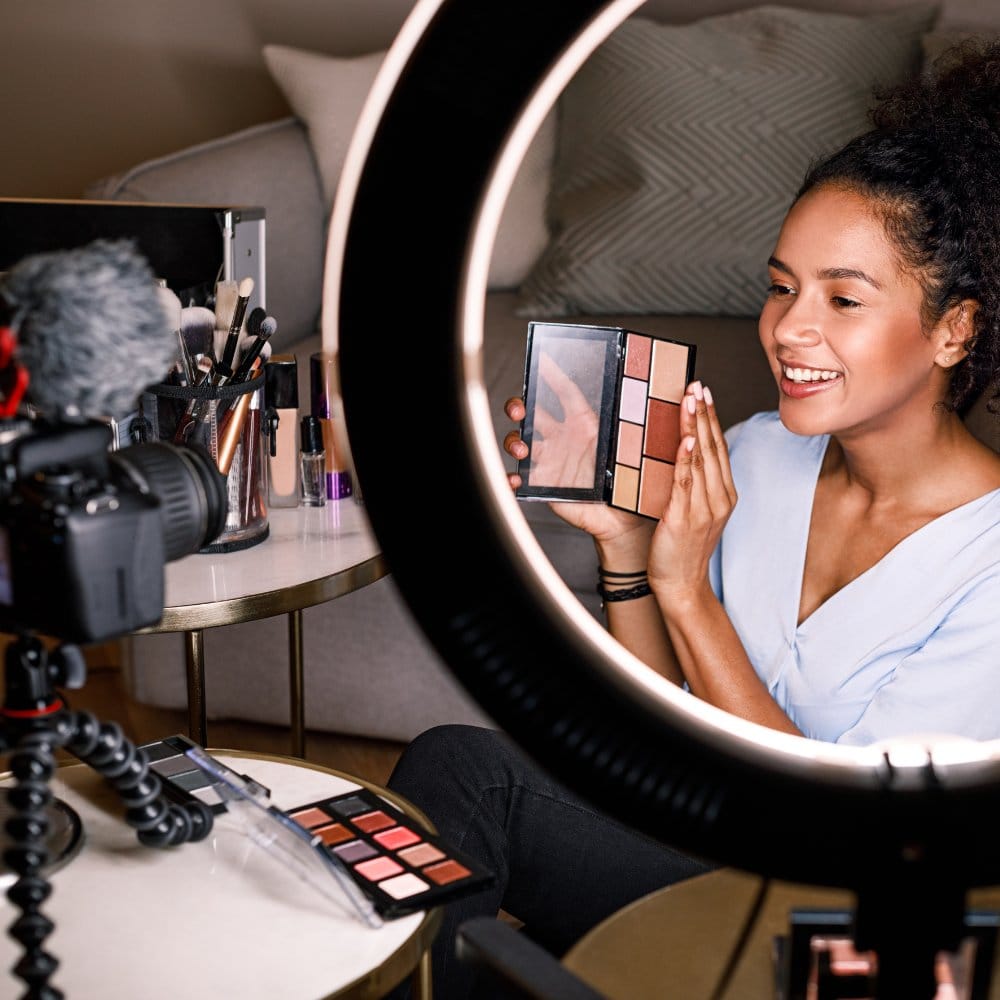Content from real people is a beautiful thing, isn't it? When you're scrolling through your feed and suddenly stop because someone's showing how that new coffee maker works in their actual messy kitchen at 7 am. That's the stuff that really connects.
You know what's even better? Brands are willing to pay top money for UGC because nothing builds trust quite like real people sharing their honest experiences in real spaces.
UGC creators can earn up to $20,000 a month by making this content for brands.
Here's a detailed walkthrough on how to become a UGC creator.
What is UGC (User-Generated Content)?
UGC (User Generated Content) is authentic content from real people about their actual experiences with products or services.
It's when someone loves a new training shoe so much they post a workout video. Or when they discover an amazing pasta sauce and share their cooking process. These posts appear naturally because people genuinely want to share their discoveries.
No brand asked for these posts. No money changed hands. UGC emerges purely from real customers wanting to show others what works (or doesn't) for them.
User-generated content is the voice of the consumer.
What is a UGC Creator?
A UGC content creator produces content for brands professionally, making it appear natural and authentic. They create videos, photos, and stories that brands use on their marketing channels and social media platforms.
UGC creators:
- Work with brands through paid contracts
- Create content appearing spontaneous and real
- Don't require social media followers
- Film in natural settings like homes and everyday locations
- Produce content for multiple companies
- Focus on authentic storytelling over polished production
Examples include filming product tutorials in a regular bathroom, demonstrating new kitchen tools in a home setting, or testing clothing items in real-life situations. The content intentionally maintains a casual, relatable style rather than a traditional advertisement feel.
Potential Earnings
UGC creators can earn significant income, ranging from a few hundred to tens of thousands of dollars per month. Top earners in the field make $10,000 to $20,000 monthly by creating engaging content for brands on platforms like TikTok, Instagram, and YouTube.
Many factors influence earnings, such as the creator's niche, audience size, engagement rates, and the types of brands they work with.
Even part-time UGC creators can make $1,000 to $3,000 per month, while full-time creators often earn $5,000 or more. As creators build their following and improve their content quality, they can attract bigger brands and command higher fees.
UGC Creators vs. Content Creators vs. Influencers
UGC creators differ from content creators and influencers in how they approach social media content.
A UGC creator makes authentic content specifically for brand channels. They film product demos and reviews in real settings, and it doesn't matter if they have zero followers because their content lives on the brand's platforms.
Content creators produce a wider range of high quality content: from videos to blogs to photos. They might create for themselves, brands, or both. Think of them as creative professionals who can adapt their style for different projects.
Influencers focus on building and monetizing their personal following. They share branded content with their audience and get paid based on their reach and engagement.
See it here below:

UGC Creator Course (SkillShare)
In this course, you’ll learn the most important knowledge and skills to start making great user-generated content (UGC) for brands, regardless of your experience with content marketing.
Why Brands Find UGC Creators Valuable
Brands worldwide can't get enough of UGC creators these days. Let me tell you why they've become such a hot commodity in marketing:
Trust Through Authenticity
Trust is hard to earn when ads are everywhere. That’s why brands turn to UGC creators. Their unfiltered, everyday content feels honest, making it easier for people to connect and believe what they see.
The numbers don’t lie: 88% of consumers trust user-generated content more than traditional ads. Real experiences simply speak louder than scripted campaigns
Cost-Effective Marketing
A traditional TV commercial costs upwards of six figures. Now imagine getting dozens of authentic product videos for the same price. That's what UGC creators offer brands.
These brand partnerships deliver engaging social media content without breaking the bank. Small businesses to major corporations can now create content that resonates with their target audience.
Quick Content Production
Social media never sleeps, right? While big productions take weeks to film one ad, UGC creators deliver fresh content almost daily.
Brands need this constant flow of authentic content to keep their social channels active. One creator might showcase a skincare routine while another demonstrates a viral gadget, all in the same day.
Real-Life Impact
UGC content hits different because it's raw and real. When someone tests a face cream in their bathroom, or brews coffee in their messy kitchen, you see the product in its natural habitat.
This genuine content answers the questions every buyer asks: "But will it work for me?" Because watching real people, in real spaces, getting real results tells you more than any polished commercial could.
What You Need to Start Creating UGC Content
You might think becoming a UGC creator requires fancy gear and a studio setup. Nope! You can get started with just a few basics. Here’s what you actually need:
- Smartphone: Use your phone for shooting. Newer models have great cameras, focus on getting clear shots and good angles.
- Tripod: Stabilize your phone for steady videos. Even a budget tripod will give you smoother, more professional-looking footage.
- Lighting: Brighten your shots with a ring light. It’s ideal for indoor filming and helps make closeups look sharp.
- Microphone: Boost your audio with a lapel mic or wired headphones. Clear sound makes your videos more engaging and easier to watch.
- Backdrops: Set up a simple, clutter-free background. Use fabric, paper, or anything you have at home to keep the focus on the product.
- Props: Add relevant props to enhance the scene. Choose items that fit your niche: coffee mugs for lifestyle content or books for a cozy look.
Start with these tools and adjust as you go. Focus on creating content that’s clear, engaging, and fits the style brands want to see. As you grow, you can level up your gear, but your creativity is what counts most.
How to Become a UGC Creator in 8 Steps
1. Pick Your Niche
Starting as a UGC creator means finding your focus area. You know, those product categories you're always researching, buying, and recommending to friends.
Take a look at what you already love testing and talking about. Into skincare? That could be your sweet spot for user generated content. Love trying coffee gadgets? That passion will show in your videos.
Tips for nailing your niche:
- Pick products you already spend money on and enjoy
- Look for categories with lots of active brands
- Choose areas you can talk about for hours
- Start with one main category, then add related ones
Success comes when you create content about products you genuinely understand. Trust me, viewers can tell when you're actually excited about what you're showing them.
2. Build Your Content Foundation
Got your niche picked out? Now it's time to create content that actually shows brands what you can do. You'll need 3-4 high-quality examples of user generated content before making any pitches.
When I'm working with UGC creators for my D2C sleep brand, I notice the best content shows real solutions. They film genuine before-bed routines with the weighted blanket, or demonstrate how it helps them unwind after a stressful day. This authentic approach to content creation tells the real product story.
What to create first:
- A detailed product review highlighting unique features
- A day-in-life video showing authentic product use
- A tutorial addressing common customer questions
- A results-focused piece showing real benefits
Keep everything authentic, that's the whole point of user generated content creation. Film in your actual spaces, use natural lighting, and talk like you're explaining things to a friend. Because at the end of the day, that's what makes UGC different from traditional ads.
3. Master Your Production Skills
Ever notice how some UGC creators seem to land all the high-paying brand deals? It happens because they've mastered a few key production techniques that make their content instantly recognizable.
For example, they:
- Edit with intention: quick cuts for energy, slow transitions for impact
- Layer sound perfectly: background music at 20%, voice-over at 80%
- Create consistent visuals: same filter, lighting, and angles across clips
- Pace their content: hook in 2 seconds, demo by 15, results by 30
- Film in segments: separate clips for intro, demonstration, and results
To master these skills, start by filming the same product sequence 10 different ways. Test various transitions, experiment with pacing, and find your signature style.
Once you nail these aspects of UGC creation, brands will start seeing you as a professional who can consistently deliver quality content.
4. Develop a Compelling Portfolio
Once you've practiced UGC creation, take some time to develop a portfolio. Working with many UGC creators, I've seen too many talented people get overlooked simply because they couldn't showcase their work effectively.
Want to know how successful creators present their portfolio? Here's their approach:
Showcase Different Content Styles
Your portfolio needs variety in UGC creation. Show how you film product reviews, capture before-and-after results, and integrate items into daily routines. When I'm hiring creators for sleep brands, I look for everything from peaceful nighttime routines to compelling benefit demonstrations.
Present Your Best Work
Don't just dump all your content into a folder. Start with your strongest piece of content created organically: maybe it's that perfect product demo or the lifestyle video that feels absolutely natural. Follow with 2-3 supporting pieces that show your range.
Make It Easy to Access
Set up your UGC portfolio on a simple website or organized Google Drive. Include both final cuts and raw footage to show your authentic filming style. The goal isn't fancy design - it's helping brands quickly see your content creation capabilities.
Remember: every piece in your portfolio should demonstrate how you can turn products into engaging stories that resonate with customers.
5. Price Your UGC Services
Pricing confuses many UGC content creators starting out. Instead of focusing on exact numbers (which change frequently), let's look at what successful UGC creators consider when setting their rates.
Usage and Rights
Consider where and how brands will use your content. Social media only? Website too? Each platform adds value. The most successful UGC creators charge differently for single-platform versus multi-platform usage.
Project Scope
Look at the full project requirements. Quick product demos need different pricing than detailed tutorials. Factor in preparation time, filming complexity, and editing requirements. Multiple filming locations or complex demonstrations deserve higher rates.
Brand Size and Budget
Match your rates to the brand's scale. Small D2C brands have different budgets than established companies. Smart content creators adjust their pricing based on brand size while maintaining their value.
Want detailed rates and pricing strategies? Check out my guide: UGC Rates: What to Charge for User-Generated Content.
Remember: Your rates should reflect the value your content brings to a brand's marketing strategy. Let your past results guide your pricing conversations.
6. Find Your First Clients
A lot of new user generated content creators hit a wall after building their portfolio. Here’s how to make sure you get paid gigs and grow your experience.
Content Marketplaces
Start with platforms like Billo and Insense. They’re a great place to get your foot in the door. Make sure your profile highlights your niche and links to your best 3 content examples, keep it professional and to the point.
Log in daily around 9-10am EST because that’s when new briefs drop, and the good ones go fast. Early gigs might pay around $100-150 per video, but they’re perfect for building reviews and getting your name out there.
Respond to briefs quickly, within 2 hours if you can. Only go for projects that fit your skills, it’s better to pick quality over quantity.
Social Media Platforms
Your Instagram and TikTok profiles are like your live portfolio. For user generated content creators, posting 3-4 times a week with different content styles is key to showing what you can do.
Keep your bio simple: “Available for UGC creation,” with your niche listed. Sign up for TikTok’s creator marketplace and use Instagram’s tools: brand managers are scouting these platforms daily.
Engage with brand accounts by commenting and sharing their posts. It’s an organic way to get noticed without pushing a direct message right away.
Other Ways to Land Clients
Direct outreach can open doors, especially with smaller D2C brands in the $1-5M range. They often need user generated content but might not know where to find creators. Look at their content, spot any gaps, and pitch an idea that fits.
Keep your message brief: mention a recent campaign, suggest a video concept, and attach a sample script. If there’s no reply, follow up after 5 days. Also, join UGC communities on Discord or Facebook for tips, leads, and even shared gigs from fellow creators.
7. Turn One-Off Projects Into Retainers
Successful UGC creators know the key to steady income is turning one-off projects into monthly retainers. Brands need a reliable stream of authentic content, and that’s where you come in, offering a package that keeps their social media active and engaging.
Let’s say you’ve just finished a project for a skincare brand. You delivered on time, experimented with different video styles, and even provided insights on the content’s performance. This is the perfect moment to pitch a retainer package that keeps their content fresh every month.
Sample Monthly Retainer Package:
Pitching a package like this shows you’re thinking ahead and solving their content needs. That's how you grow from a gig worker to a successful UGC creator with a steady, predictable income.
8. Scale up
The gigs are rolling in, so why slow down now? It’s time to turn your side hustle into a steady income stream.
Think of yourself as a content chameleon, adapting your style to fit whatever brands need. Flexible footage means creating versatile clips they can use across TikTok, Instagram, or even on their website. You can also offer raw footage packages, which gives brands extra material to edit and repurpose for multiple uses.
Other ways to grow as a user-generated content creator:
- Build a network of collaborators: Partner up with other UGC creators for joint projects or cross-promotions. It’s a great way to expand your audience and access new client opportunities.
- Upgrade your production quality: Small gear upgrades like better lighting or a good microphone can take your videos from decent to impressive. High-quality content often commands higher rates.
- Keep refining your skills: Experiment with different video styles and editing techniques. Brands love creators who stay on trend and bring innovative ideas.
- Focus on client retention: Keep in touch with past clients. Check how your content performed, then pitch fresh ideas for their next campaigns. Satisfied clients often turn into repeat customers.
Helpful Tools for UGC Creators
Most UGC creators I know have a few trusty tools they rely on every day. These tools save time, simplify the editing process, and help you deliver content that clients love.
P.S. I use many of them myself; they make creating high-quality UGC a whole lot easier.
Here are the tools:
Canva
Canva is the graphic design tool most creators swear by.
It’s simple to use and helps you whip up thumbnails, social media posts, or media kits in minutes.
With its drag-and-drop features, even non-designers can create professional visuals fast. No fuss, just results.
CapCut
CapCut is a quick, mobile-friendly video editor.
When clients ask for changes, you don’t need bulky software, just trim clips, add text, or use effects directly from your phone.
It’s perfect for handling last-minute edits and getting content ready on the fly.
Frame.io
Frame.io simplifies client feedback like nothing else.
Upload your video, and clients add comments directly on the timeline.
You skip the messy emails and fix issues faster with clear, pinpointed notes.
Notion
Notion is the all-in-one tool for staying on top of your projects.
Keep client notes, deadlines, and your content calendar in one easy-to-access space.
It’s a lifesaver for avoiding scattered docs and endless tabs, everything’s right where you need it.
HoneyBook
HoneyBook streamlines contracts, invoices, and client communication.
It’s built for freelancers who want to handle admin tasks quickly, so they can get back to creating.
You send a contract, track payments, and manage projects, all in one tidy app.
Tezza
Tezza brings your photos and videos to life with stylish presets.
It’s a favorite among creators for adding that extra pop and consistency to content.
With just a few taps, your visuals can match the aesthetic brands.
Wipster
Wipster takes the hassle out of content reviews.
You upload your video, and team members or clients can leave timestamped feedback right on the video itself.
It keeps everyone on the same page and cuts down on confusing email chains.
UGC Creator Trends to Watch Out For
UGC content creation is changing fast. What worked six months ago might not land you brand deals today. Having worked with multiple creators, I'll share exactly what brands are investing in right now.
Personality-Driven Content
Remember those faceless product demos that dominated 2023? They're out. Brands like Sephora and Nike now want to see you - your reactions, your daily routines, your genuine product experiences.
I've watched creators double their rates simply by showing their face and personality. When you demonstrate that face cream in your actual bathroom, sharing real results over time, brands see higher engagement.
Audio-First UGC
Seen those UGC videos with voiceovers taking over your feed? Brands are investing heavily in audio-focused content. Podcasts, voice notes, and story-style narrations are becoming as important as visuals.
I'm seeing beauty and tech brands particularly loving this format. When you narrate your skincare routine or explain product features in a conversational way, it feels like a friend sharing advice.
Platform-Specific Content
Gone are the days of posting the same video everywhere. TikTok wants raw authenticity, Instagram Reels needs polished aesthetics, and YouTube shorts demand quick, valuable information.
Creators now adapt their content for each platform's unique style. A morning routine video might be casual and funny for TikTok, beautifully edited for Instagram, and educational for YouTube, all using the same base footage.
Community-Focused Campaigns
Solo product reviews are evolving into community experiences. Brands want creators who can spark conversations in comments and build genuine communities around products.
The most successful UGC creators now facilitate discussions, respond to viewer questions, and create content that encourages audience participation.
AI-Enhanced Production
Your raw, authentic style still matters, but now it needs polish. Brands expect clean audio, perfect captions, and consistent quality. The good news? AI tools make this easier than ever.
When pitching to brands like L'Oreal or Samsung, being familiar with production tools can give you an edge. They're looking for creators who can deliver both authenticity and professional quality.
UGC Creator Examples
Ryan Santoyo (@oneoffryan on TikTok)
Ryan Santoyo goes straight for DTC brands. He skips the random product collabs and focuses on items he actually uses, like gadgets and sleep products. He also shares tips on creating UGC and even runs a course to help new creators get started. Ryan’s approach? Be transparent and show the behind-the-scenes of your process.
Tip: Stick to products you’re familiar with. It’s easier to create real, engaging content when you know the ins and outs of what you’re showcasing.
Dr. Hazel Wallace (@thefoodmedic on Instagram)
Dr. Hazel combines her medical expertise with easy-to-follow wellness advice. Her feed is full of healthy recipes and practical tips that don’t require a degree to understand. It’s simple, relatable content that keeps her audience engaged.
Tip: Make your knowledge approachable. When people can apply your advice easily, they stick around for more.
Simon Hill (Fiverr Pro)
Simon Hill’s voice has become a staple in commercials, cartoons, and even video games. He’s known for his fast delivery and knack for adapting to different brand tones. Clients like Mattel stick with him because he delivers quality every time without fuss.
Tip: Specialize in what you’re great at and stay consistent. Brands notice when you show up ready every single time.
Miah Velasquez (@miahvelasquez on TikTok)
Miah’s dance routines grab your attention right away. Her style is both fierce and fun, with a contagious energy that lights up every video. No wonder brands love working with her, she has a knack for promoting items in a way that feels natural and exciting.
Tip: Use your passion to showcase products. When you bring energy, it makes everything you feature more memorable.
UGC Creator Loading...
Whew, that was a lot! But we’re finally done.
Now that you know what it takes to become a UGC creator, it’s time to get started. You have the basics, the tools, and real examples to guide you.
Remember, it’s the raw, unfiltered content that makes UGC powerful. So grab your favorite product and hit record, let your creativity do the selling.
UGC Creator FAQs
Do I need a large following to become a UGC creator?
No, you don’t. Brands look for creators who can film content that feels real and relatable. It’s your creativity and ability to tell a story that matters. If you can show a product naturally, you’re already what they want.
Is it worth becoming a UGC creator?
Definitely. If you love creating content and enjoy trying out new products, it’s a great way to get paid. You have the freedom to choose projects, build your style, and work with different brands. Many start small but turn it into a steady income.
Do I need fancy gear to create UGC?
Nope. Start with your phone, some good lighting, and a basic editing app like CapCut. You can always upgrade later. For now, focus on nailing the content itself: angles, storytelling, and clarity matter more than high-end equipment.
Do I have to show my face?
Not if you don’t want to. Some creators focus on product close-ups, voiceovers, or aesthetic shots. It’s all about how you present the product and tell its story. You can still make engaging content without stepping in front of the camera.








